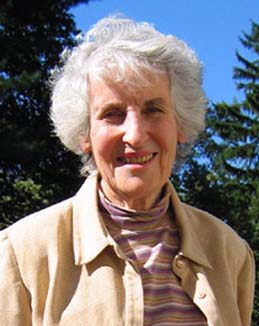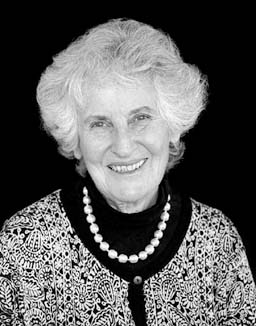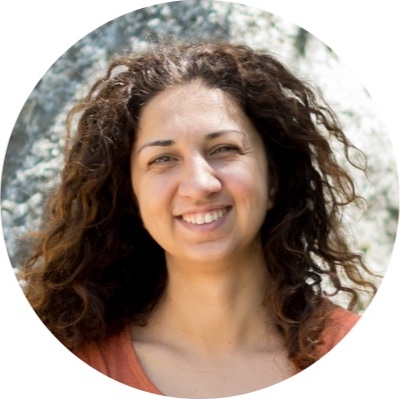by/di Valentina Disarlo
![]() English version below / Vai alla versione italiana
English version below / Vai alla versione italiana

In the acclaimed “A Mathematician’s Apology”, published in 1940, G. H. Hardy states that “[...] mathematics, more than any other art or science, is a young man's game”. The author, then 62 years old, cites as examples Riemann, Gauss and Ramanujan, and continues, “I do not know of a single instance of a major mathematical advance initiated by a man past fifty”. To this day the most coveted prize in Mathematics is the Fields Medal – a prize awarded every four years to the best mathematicians under 40 years of age. Until 1978, when the Wolf Prize was established, there were no high-level prizes for mathematicians older than 40; the Abel Prize, considered by many the equivalent of a Nobel Prize for Mathematics, has been established as recently as 2003.
Joan S. Birman, one of the leading experts on braid groups and knot theory, is a female counterexample to Hardy’s apodictic judgement. Born in 1927, Joan Birman started her Ph.D. when she was 34, and got her degree at Courant Institute when she was 41. She had 21 Ph.D. students and, aged 90, she is still active in mathematical research. Among the several awards she was presented with throughout her career are a Sloan Foundation Fellowship (1974-1995), a Guggenheim Fellowship (1994-1995) and an AMS Fellowship (2012). She is a member of the European Academy of Sciences since 2003 and a honorary member of the London Mathematical Society since 2015.
Hers is not the story of a child prodigy with a very precocious talent and an innate call to the subject from a very early age; nor does her career start with a sudden brilliant idea before she was 30 years old. Joan Birman’s story is one of curiosity and patience and provides also a good example of the challenges women of her time had to face. In this post I will try to briefly touch some key stages in her education. For those interested in more Joan Birman, there is a long interview here.
Joan S. Lyttle Birman was born in New York in 1927 in a Jewish family of european descent. Her mother was a Polish born housewife, her father a Russian immigrant who, having arrived at seventeen in the New World, had managed to open a small textile manufacture after long years as clerk. Even though neither of her parents had completed school, both always encouraged Joan and her three sisters to commit to their studies. In her teen years Joan attended a girls only school, where she discovered the beauty of mathematics, thanks to a talented geometry teacher. She then entered Swarthmore College, where – on top of mathematics – she got interested in Physics, Literature and Psychology. She moved to Barnard College and started to take Mathematics classes at Columbia University, realising she was often the only woman in the room. “I caught the idea that maybe math was not for girls,” she would comment later. The Bachelor of Arts, received in 1948, was followed two years later by a Master of Arts in Physics from Columbia University. In those years she started to feel some pressure from her family: “My parents not only expected their four daughters to get married, but we were to get married in order! There was all kinds of nonsense like that,” she would recall. She married her fellow student Joseph Birman, also born in 1927, in 1950, the same year she received her M.A. in Physics. She liked the subject, but she felt she lacked the right intuition to continue her studies. A ten year long pause from academia followed. In this time Joan was employed as an applied mathematician by three different firms in the aviation industry, working on signal analysis and on the first navigation computers. She really enjoyed her work and her husband stood by her in this choice, which was quite unusual at the time. The birth of their first child brought new challenges: there was no daycare for children, Joan did not feel like leaving her son with a stranger and decided to slow down her working pace. She never left her job completely, she kept on working part-time a few days a week.
The opportunity to go back to her studies came when her husband was hired by New York University: Courant Institute had an excellent offer of evening classes she could attend for free. She enrolled in a Ph.D. programme in 1961 and started taking two courses per year. After passing her qualification exam, she chose to work on topology and started looking for a supervisor. Given her unorthodox cursus studiorum, this was not an easy task. Finally Wilhelm Magnus, whose student she had been in the past, accepted to be her advisor. He gave her the first papers by Fadell and Neuwirth on braid groups to read and encouraged her to work on a generalisation for a certain class of surfaces. Joan managed to go way beyond that, generalising her result to all surfaces. Her dissertation “Braid groups and their relationship to mapping class groups” marked the beginning of a new research topic – mapping class groups of surfaces – which is still thriving today.
If this story left you curious to know what a braid group is, you can watch the amazing videos made by Ester Dalvit.
The images in this post are taken from the MacTutor History of Mathematics archive.
![]() Versione italiana a seguire / Back to English
Versione italiana a seguire / Back to English

Nel celebre “Apologia di un Matematico”, pubblicato nel 1940, G. H. Hardy afferma che “la matematica, più di ogni altra arte o scienza, è un gioco per giovani”. L’autore sessantaduenne porta ad esempio Riemann, Gauss e Ramanujan e continua dicendo “Non sono a conoscenza di alcun grande progresso matematico iniziato da un uomo oltre i cinquant’anni”. Ancora oggi il riconoscimento più ambito in matematica resta la Medaglia Fields – un premio assegnato ogni quattro anni ai migliori matematici sotto i 40 anni. Fino al 1978, anno di istituzione del premio Wolf, non vi erano premi di alto livello per i matematici che avessero passato i quarant’anni; anche il premio Abel, da molti considerato l’equivalente del Premio Nobel per la matematica, è stato istituito solo nel 2003.
Joan S. Birman, fra i massimi esperti al mondo di gruppi di trecce e teoria di nodi, è uno dei controesempi al femminile al giudizio apodittico di Hardy. Nata nel 1927, Joan Birman inizia il dottorato a 34 anni, conseguendo il titolo di dottore di ricerca al Courant Institute a 41 anni. Ha avuto 21 dottorandi e all’età di 90 anni è ancora attiva nella ricerca matematica.
Fra i molti riconoscimenti che ha ricevuto ricordiamo la Sloan Foundation Fellowship (1974 - 1995), la Guggenheim Fellowship (1994-1995) e la AMS Fellowship (2012). È membro della European Academy of Sciences dal 2003 e membro onorario della London Mathematical Society dal 2015.
La sua non è la storia di una bambina-prodigio che mostra un precocissimo talento e una innata vocazione per la disciplina fin dalla più tenera età; né tantomeno la sua carriera inizia con una improvvisa e geniale intuizione avuta già da studentessa. La storia di Joan Birman è invece fatta soprattutto di curiosità e pazienza e si mostra inoltre esemplificativa delle difficoltà affrontate dalle donne della sua generazione. Nel seguito proveremo a raccontarvi brevemente alcune tappe salienti della sua formazione. Chi volesse può trovare una lunga intervista (in inglese) qui.
Joan S. Lyttle Birman nacque a New York City nel 1927 in una famiglia ebraica di origine europea. Sua madre era una casalinga di origini polacche, suo padre un immigrato russo che, arrivato a diciassette anni nel Nuovo Mondo, era riuscito a mettere su una piccola azienda tessile dopo aver lavorato a lungo come impiegato. Sebbene nessuno dei suoi genitori avesse portato a termine le scuole superiori, entrambi avevano sempre spronato Joan e le sue tre sorelle ad impegnarsi negli studi. Durante gli anni dell’adolescenza Joan frequentò una scuola per sole ragazze, dove scoprì la bellezza della matematica grazie ad una brava insegnante di geometria. Si iscrisse poi allo Swarthmore College, dove – oltre alla matematica – si interessò anche di fisica, letteratura e psicologia. Trasferitasi al Barnard College, prese poi a frequentare le lezioni di matematica alla Columbia University, scoprendosi spesso l’unica donna in aula. “Ne trassi l’idea che forse la matematica non fosse adatta alle ragazze” dirà poi. Al Bachelor of Arts ottenuto nel 1948, seguì un Master of Arts in Fisica conseguito alla Columbia University due anni più tardi. Erano anni in cui le pressioni familiari si facevano sentire – “i miei genitori non solo si aspettavano che tutte e quattro le loro figlie si sposassero, ma anche che lo facessero in ordine di età!” – dirà poi. Sposò il compagno di studi e coetaneo Joseph Birman nel 1950 e in quello stesso anno conseguì il Master of Arts in Fisica. Malgrado la disciplina le piacesse, non sentiva di avere la giusta intuizione per proseguire gli studi. Al diploma seguì una pausa dall’accademia durata oltre dieci anni. In questo lasso di tempo Joan lavorò come matematica applicata presso tre diverse aziende nell’industria aereonautica, occupandosi di analisi dei segnali e dei primi computer di navigazione. Lavorare la appassionava molto e il marito la sostenne fermamente in questa sua scelta assolutamente inusuale per i tempi. L’arrivo del loro primo figlio pose nuove difficoltà: non c’erano asili per i bambini, Joan non se la sentiva di lasciare il bambino ad un’estranea e decise di rallentare il proprio ritmo lavorativo. Non abbandonò mai del tutto il lavoro però, continuò part-time pochi giorni alla settimana.
L’occasione che le permise di riprendere gli studi arrivò grazie all’assunzione del marito alla New York University: il Courant Institute offriva infatti un eccellente programma di corsi serali di cui Joan poteva fruire gratuitamente. Nel 1961 si iscrisse dunque alla scuola di dottorato e prese a seguire due corsi l’anno. Superato l’esame di qualificazione per il Ph.D., decise di occuparsi di topologia e si mise alla ricerca di un relatore di tesi. Essendo il suo cursus studiorum alquanto inusuale, non le fu facilissimo trovare un relatore. Fu Wilhelm Magnus, che già l’aveva avuta come studentessa, ad accettarla come tesista. Le assegnò da leggere i primi lavori di Fadell e Neuwirth sui gruppi di trecce e le propose di lavorare ad una loro generalizzazione per una certa classe di superfici. Joan riuscì ad andare ben oltre, generalizzando i suoi risultati a tutte le superfici. La sua tesi “Gruppi di trecce e loro relazioni con i gruppi modulari” segnò l’inizio di un settore di ricerca - quello dei gruppi modulari di superfici - che è vivace ancora oggi.
Se volete sapere cosa è un gruppo di trecce guardate il bellissimo film realizzato da Ester Dalvit.
 Valentina is a Postdoc in Geometric Topology at Heidelberg Universität in Germany. Having grown up in a small town in Salento, she got interested in maths as a teenager thanks to the Italian Maths Olympiad and a noisy 56k modem. After being a contestant in the Italian Finals in Cesenatico, she started solving the beautiful problems posted on the OliForum and its mailing list. She has lived abroad since 2010, and has worked in France and the US, where she also attended many events and panels discussing the gender gap in STEM fields. When she is not doing maths, she enjoys reading good literature, traveling, volunteering and dancing rueda de casino.
Valentina is a Postdoc in Geometric Topology at Heidelberg Universität in Germany. Having grown up in a small town in Salento, she got interested in maths as a teenager thanks to the Italian Maths Olympiad and a noisy 56k modem. After being a contestant in the Italian Finals in Cesenatico, she started solving the beautiful problems posted on the OliForum and its mailing list. She has lived abroad since 2010, and has worked in France and the US, where she also attended many events and panels discussing the gender gap in STEM fields. When she is not doing maths, she enjoys reading good literature, traveling, volunteering and dancing rueda de casino.